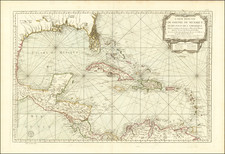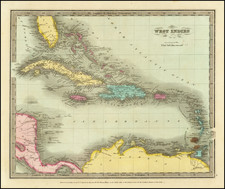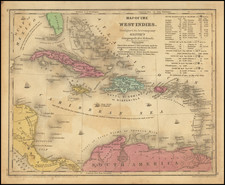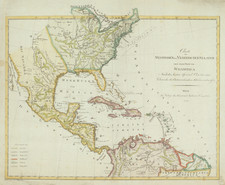The Only Known Example of the the first Printed Map of Ocho Rios, Jamaica.
The present map is an unrecorded plan of the Shaw Park Estate, a plantation which surrounded the village of Ocho Rios on the north coast of Jamaica. As such, it is the earliest known printed map to focus on Ocho Rios and its environs.
The Shaw Park Estate was part of the vast land holdings in St. Ann's Parish that had been in the Shaw family since the late seventeenth-century. An especially well planned and landscaped property, it commanded excellent views of the harbour. Occupying almost 600 acres, it was primarily planted with sugar cane, along with groves of pimento. When the family patriarch John Shaw died in 1821, the property was left to his son-in-law, James Walker (1784-1844), a Scottish doctor who had married Shaw's daughter, Elizabeth Olivia Shaw. Walker attained prominence in his own right, being elected to the island's Legislative Assembly, representing St. Ann's.
The site of Shaw Park figured prominently in the history of Jamaica. During the Spanish period, the area was called "Las Chorreras" (The Waterfalls), owing to the numerous cataracts formed as the rivers cascaded over the limestone ridge which backs the bay. This name was eventully corrupted by the English to become 'Ocho Rios'. One of these falls is the now famous as Dunn's River Falls. The location of Shaw Park was notable as the site of the Battle of Las Chorreras (1657), where the English Colonel Edward D'Oyley defeated the last Spanish governor of Jamaica, Don Cristobal Arnaldo de Ysassi, which presaged the Spanish departure from the island. It was said that at the time that this map was produced, ordnance from the battle could still be seen amidst the cane fields.
The Shaw Park Estate was the scene of a dramatic incident which transpired only a couple of years before the present map was drafted. It had been decreed that slavery was to be abolished throughout the British Empire on August 1, 1834. Following that date, the freed slaves were to be obliged to a system of apprenticeship for a period of four years, although the terms of this arrangement were (perhaps deliberately) left to be rather vague. This transition was relatively peaceful on most plantations, as the estate proprietors, who had themselves been granted financial compensation by the crown, agreed to pay thier workers some form of wages or support in kind. Walker had apprently made no such provision, and upon the stroke of emancipation, his workers immediately threw down their hoes, declaring that King William had 'made them free'. They then refused to resume their work unless they were paid. Walker was indignant, and a tense standoff ensued. He sent an express messanger to the capitial, Spanish Town, to request help from the governor, the Marquess of Sligo. The governor, in turn, dispatched a small force under Lt. Colonel Sir Henry Macleod, which sailed from Kingston aboard the HMS Rhadamanthus around the eastern part of the island, before landing at Ocho Rios. Macleod arrived to find a very serious situation, in which the former slaves were on the verge of open insurrection. Through a mixture of cojoling and coersion, Macleod managed to difuse the situation. Shaw Park continued to function as a sugar plantation until 1892, when its acreage switched to orange production destined for the American market.
The present map is a very finely surveyed plan of a Jamaican estate, and provides a wealth of information on plantation life at the time of Emancipation. The estate is carefully divided into sectors, colored in an attractive blue wash. The various aspects of production correspond to the 'Reference' table located to the right of the map, which details land use meticualously by acre. All buildings and works are marked, as are the major roads, for one of the principal routes connecting the north and south coasts of Jamaica ran strait through Shaw Park. Walker evidently went to considerable expense to have his lands professionally surveyed, and even more extraordinarily went to the trouble of having it lithographed in Glasgow, a testament to the great value he placed on the plan. The present example is likely the only surviving copy, as the map would have had a practical use, making it especially vulnerable to wear and damage in a tropical climate. The excellent condition of the present example, which appeared in Scotland, suggests that it was likely secreted away for safe keeping by an associate of Walker in his native land.
The village of Ocho Rios occupies the upper center of the map. While consisting of only a cluster of wharehouses and fishing shacks, it was nevertheless an important local center of comemrce. The bay's fine anchorage and the abundance of fresh water, ensured that it was a popular haven for trading vessels and naval frigates. Importantly, the present plan is the earliest printed map to focus on Ocho Rios and its envirions.
Ocho Rios remained a sleepy agrarian and fishing community until the 1950s when tourists began to flock to the area, attracted by its fine beaches, waterfalls and the botanical phenominon 'Fern Gully', which lines the road leading into the interior. Much of Shaw Park was eventually sold off to make way for the expansion of the town, although the core of the estate now hosts a botanical garden which commands magnficent views of the bay.










![Carte Des Antilles Du Golfe Du Mexique et d'une partie des Etats voisons…1842 [Republic of Texas]](https://storage.googleapis.com/raremaps/img/small/98848.jpg)



